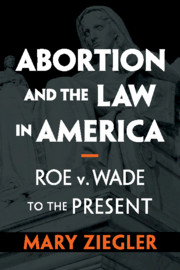Book contents
- Abortion and the Law in America
- Abortion and the Law in America
- Copyright page
- Dedication
- Contents
- Acknowledgments
- Timeline
- Abbreviations
- Introduction
- 1 Roe v. Wade and the Rise of Rights Arguments
- 2 The Hyde Amendment and Its Aftermath
- 3 Launching a Quest to Reverse Roe
- 4 Planned Parenthood v. Casey, the Family, and Equal Citizenship
- 5 Contesting the Relationship between Abortion and Health Care
- 6 Partial-Birth Abortion and Who Decides the Costs and Benefits
- 7 Polarization, Religious Liberty, and the War on Women
- Conclusion
- Notes
- Index
2 - The Hyde Amendment and Its Aftermath
Published online by Cambridge University Press: 28 February 2020
- Abortion and the Law in America
- Abortion and the Law in America
- Copyright page
- Dedication
- Contents
- Acknowledgments
- Timeline
- Abbreviations
- Introduction
- 1 Roe v. Wade and the Rise of Rights Arguments
- 2 The Hyde Amendment and Its Aftermath
- 3 Launching a Quest to Reverse Roe
- 4 Planned Parenthood v. Casey, the Family, and Equal Citizenship
- 5 Contesting the Relationship between Abortion and Health Care
- 6 Partial-Birth Abortion and Who Decides the Costs and Benefits
- 7 Polarization, Religious Liberty, and the War on Women
- Conclusion
- Notes
- Index
Summary
In studying the success of abortion-funding bans, Chapter 2 evaluates the rise of a strategy based on claims about the costs of abortion. In the mid-1970s, the antiabortion movement included self-described liberals and conservatives, absolutists and pragmatists, professionals and homemakers. All of these activists focused on a constitutional amendment that would have criminalized abortion, and groups like NRLC and AUL looked for laws that could reduce the abortion rate in the short term. In justifying laws like abortion-funding restrictions, pro-lifers highlighted what they described as the societal costs of paying for abortion. While groups like NARAL and Planned Parenthood reluctantly discussed the impact of abortion-funding bans on poor women, lawyers in the ACLU invited courts to look at the real-world effects of funding prohibitions on taxpayers and low-income women. Resulting in decisions like Maher v. Roe (1977) and Harris v. McRae (1980), this dialogue reflected broader changes in public attitudes about poverty and the social-safety net.
Keywords
- Type
- Chapter
- Information
- Abortion and the Law in AmericaRoe v. Wade to the Present, pp. 27 - 57Publisher: Cambridge University PressPrint publication year: 2020
- 1
- Cited by



